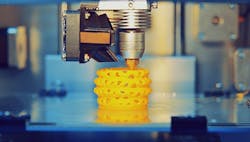3D-Printing Process Holds 4D Possibilities
Researchers at Loughborough University, Loughborough, U.K., have developed a hybrid additive manufacturing process to selectively control the mechanical properties of 3D-printed parts.
The process uses acetone to toughen targeted layers of 3D-printed parts and structures. The acetone, depending on the amount used and where it’s applied, enables creation of novel mechanical characteristics, such as controlling how parts deform.
An article in a recent issue of Additive Manufacturing describes the new process, which is dubbed Material Treatment Extrusion Additive Manufacturing (MaTrEx-AM).
Essentially, the researchers added another property to products made by the established Material Extrusion Additive Manufacturing (MEAM) 3D-printing process.
MEAM has become increasingly popular in recent years, not least because it gives users the ability to rapidly manufacture custom parts with complex geometries. These, point out the authors, often are prohibitively costly or time consuming to achieve by traditional subtractive manufacturing methods.
MEAM operates by extruding molten polymer filament and depositing it via a heated nozzle onto a print platform, where it rapidly solidifies. Typically, the nozzle moves in the X and Y planes (parallel to the print platform) to generate layers of parts sequentially. The lowering of the print platform in the Z direction at completion of each layer enables depositing subsequent layers, leading to a layer-wise production.
Herein, note the authors, lies the biggest limitation in MEAM: mechanical anisotropy, particularly weakness in the Z direction.
Historically, this anisotropy has been attributed to deficiencies in the interlayer bonding, the researchers note. However, their research points to the true cause of interlayer weakness being geometrical, with naturally occurring filament-scale grooves causing stress concentration and reducing a load-bearing area by narrowing the bond region.
While chemical treatments have addressed this in the past, most focused on using acetone to improve surface finish of 3D-printed parts — with only the short-term effects of its use investigated. Furthermore, these studies did not analyze the evolution of mechanical and geometrical properties over time.
In contrast, the Loughborough team maintain this is the first study to demonstrate the selective tailoring of mechanical and geometrical properties of polylactide (PLA) and acrylonitrile butadiene styrene (ABS) additively manufactured with material extrusion using a newly devised treatment method of chemical immersion in acetone.
This combination of manufacturing and chemical treatment results in a hybrid process capable of modifying mechanical behavior in a predictable and time-controlled manner.
Analyzing short-term effects (tested immediately after immersion) generated important findings on mechanical and geometrical properties of printed specimens. Different immersion times (1–60 seconds) caused significant increases in strain-at-fracture — up to 25- and 16-fold for PLA and ABS, respectively. The researchers found, in the long-term, mechanical properties recovered by up to 90% for untreated specimens in ABS within three hours, while PLA properties recovered after 60 days.
Importantly, while mechanical properties in both PLA and ABS recovered, the geometrical changes were retained. Annealing allowed for shorter recovery time: PLA specimens fully recovered within 24 hours.
“Chemical immersion provides significant advantages over widely used vapor-based treatment methods, since it allows selective application to be achieved and localized changes of mechanical and geometrical properties,” they write. So MatrEX-AM enabled increased toughness and a redirection of strain into selected regions of the mesh material.
Andy Gleadall, senior lecturer in additive manufacturing in Loughborough’s school of mechanical, electrical and manufacturing engineering, says, “The process adds material layer-by-layer — there are grooves between the layers, a bit like you’d see if you stacked lot of logs sideways on top of one another, all lined up. 3D-printed parts are often weak because of the way layers are laid down in sequence, so there are geometric defects between the layers and the bonding of material between layers may not be as good as the pure polymer.”
“The new capabilities are potentially valuable for a huge range of parts and structures, but perhaps most obvious ones would be parts that deform during operation and the way in which they deform needs to be controlled. The time-dependent nature of mechanical properties means the approach adds a new dimension to material capabilities, with in-situ hybrid processing facilitating a true 4D-printing process,” he concludes.
Seán Ottewell is Chemical Processing's editor at large. You can email him at [email protected].

